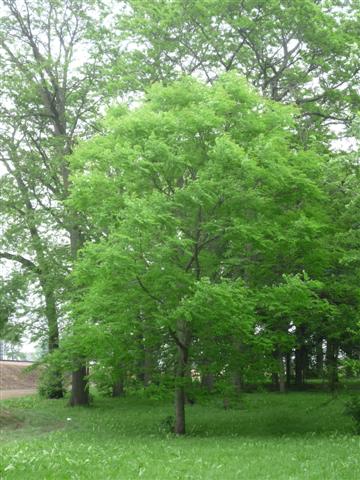By Dr. Charlie Rohwer
Since my last guest professor submission (buying organic food for health) garnered so much discussion, I thought I’d try to write about a less controversial topic: evolution. There’s no scientific doubt that’s where plants (well, all species of everything, really) come from, but what got me thinking about it recently was my Kentucky coffeetree.
My wife and I bought our first house a couple years ago, and for the previous 25 years at least, the landscaping had been severely neglected. Ubiquitous rock mulch on top of plastic, a cherry covered in black knot, and zero space used for any kind of garden, unless you count the 2 sedum suffering under rocks and plastic. So we made lots of garden space and bought our first tree, a Gymnocladus dioicus. But as the epithet indicates, Kentucky coffeetree is dioecious. The plant either has male flowers or female flowers. We liked the fact this tree will get tall but not spread too wide, tolerate our soil, have interesting bark and leaves, and the winter shade will be fairly sparse, but we didn’t really want to have the big seed pods from the females. We bought an unsexed plant in 2009 and hoped for the best. Make no mistake, we were proud parents, regardless of the sex of our newly-planted 7-foot stick. It flowered this year, with only stamens. It’s a boy! But it got me thinking, where and when did its dioecism come from? It amazed me that I hadn’t considered it before because I actually work with another dioecious plant, hops (Humulus lupulus).

Flowering plants probably started their evolutionary timeline with both male and female parts near each other. Carpels (female) and stamens (male) are specialized places where male and female gametes (sperm and egg) are made, fused, and the young sporophyte, as a developing embryo, is protected in maternal structures. Sounds familiar, but as Bert stated in a recent post, we need to strictly avoid teleology. In fact, though more common in some parts of the world, dioecism is the exception in flowering plant reproduction (<10% of species). Most flowers you see are hermaphroditic, with both male and female parts together in the same flower. Dioecism is so dispersed among plant genera, it’s probably evolved many different times, and is thought to arise through a series of evolutionary steps. For example, in one mechanism, some individuals within a species loose the ability to make pollen (genetically), and some plants within that species can still produce both male and female flowers. Then selection can act on the two types of plants separately, and at some point, the ability to make female parts disappears in the hermaphroditic line. But there are different ways to arrive at dioecism that help to explain how it arose multiple times in so many diverse plant lineages. Genera other than Gymnocladus (a legume) and Humulus (complicated taxonomy, but clearly related to Cannabis) that have evolved to be dioecious include Spinacia (spinach, an amaranth), Pistacia (pistachio, in the cashew family), Asparagus (a monocot), Dioscorea (yam, in the….yam family), and Ginkgo (not even classified as a flowering plant, and not a conifer either!).

Kentucky coffeetree is a legume, but think of every other legume you know and dioecism is the exception, by far. Pollination and dispersal mechanisms, optimization of reproductive resources, and outcrossing pressure are thought to drive evolution of these species away from hermaphroditic flowers. Evidently this happened to the Kentucky coffeetree lineage by 50 million years ago. About 40 percent of the time that flowering plants have existed, Gymnocladus has been dioecious. That’s 1 million times longer than a 50-year-old person has existed. Dinosaurs had been extinct for 15 million years or so by the time the Kentucky coffeetree lineage split from other legumes. Those are numbers we have a hard time grasping because natural processes have been around a lot longer than we have.
Reading:
Ainsworth, 2000. Boys and girls come out to play: the molecular biology of dioecious plants. Ann. Bot. 86:211–221.
Doyle and Luckow, 2003. The rest of the iceberg. Legume diversity and evolution in a phylogenetic context. Plant Physiology 131:900–910.
Specht and Bartlett, 2009. Flower evolution: the origin and subsequent diversification of the angiosperm flower. Ann. Rev. Ecol. Evol. Syst. 40:217–243.
Thanks Charlie for the interesting discussion.
While there’s only one today, many more species of ginkgoes existed when dinosaurs roamed the earth. There is a theory that the dinosaur extinction was due to the terrible stench of the ginkgo fruit.
Seriously, if you plant a ginkgo in your landscape or urban setting, make sure it’s a male tree. The fruit makes a mess and it stinks of butyric acid and smells like a baby’s messy diaper. If it’s not been certified as a cloned male, you won’t know its gender for sure until it’s about 30-years old. Gardener beware.
I wrote about the gender inequality of my sagos, which are cycads and are primitive like the ginkgoes. http://www.sky-bolt.com/garden/garden13.htm#sagosex
Thanks! For some reason, the Kentucky Coffeetree has popped up in my reading several times in the last few days. I wasn’t familiar with it — it’s quite handsome.
Elizabeth
Re: Ginny
I have noticed younger ginkgoes fruiting in the last few years. I don’t know if it is due to selective breeding to weed out the females earlier or what, but I have seen 6″ diameter ginkgoes with seed.
BTW, Coffeetree is one of my favorites for urban plantings. Once you convince the resident that it will eventually fill out, they are usually fine with it too.
Hi, I just came across your photo above of the Kentucky coffeetree flower up close. I’d like to use it for a free urban tree planting program in Massachusetts – it’s really nice! Any chance that’s possible? It’s completely non-commercial: our program is sponsored by the State and the trees are free. Thanks!
Feel free to use either photo! They’re my own.